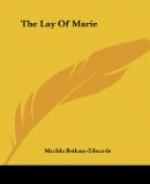Fauchet was unacquainted with the Lays of Mary, for he only mentions her fables[12]. But, what is more astonishing, Monsieur le Grand, who published many of her lays, has not ascribed them all to her. He had probably never met with a complete collection like that in the British Museum; but only some of those that had been separately transcribed; and, in that case, he could not have seen the preface, in which Mary has named herself.
The second work of our poetess consists of a collection of fables, generally called Aesopian, which she translated into French verse. In the prologue she informs her readers that she would not have engaged in it, but for the solicitation of a man who was “the flower of chivalry and courtesy,” and whom, at the conclusion of her work, she styles Earl William.
Por amor le counte Guillaume,
Le plus vaillant de cest royaume,
Mentremis de cest livre faire,
Et de l’Anglois en Romans
traire, &c.[13]
M. le Grand, in his preface to some of Mary’s fables, which he has published in French prose, informs us that this person was Earl William de Dampierre. But William, Lord of Dampierre, in Champagne, had in himself no right whatever to the title of Earl. During the 13th century, this dignity was by no means assumed indiscriminately, and at pleasure, by French gentlemen; it was generally borne by whoever was the owner of a province, and sometimes of a great city, constituting an earldom: such were the earldoms of Flanders, of Artois, of Anjou, of Paris, &c. It was then, that these great vassals of the crown had a claim to the title of earl, and accordingly assumed it.[14] Now, the territory of Dampierre was not in this predicament during the 13th century; it was only a simple lordship belonging to the lords of that name.[15]
Convinced, as I am, that Mary did not compose her fables in France, but in England, it is rather in England that the Earl William, alluded to by Mary, is to be sought for; and luckily, the encomium she has left upon him is of such a nature, as to excite an opinion that he was William Longsword, natural son of Henry II. and created Earl of Salisbury and Romare by Richard Coeur de Lion. She calls him




